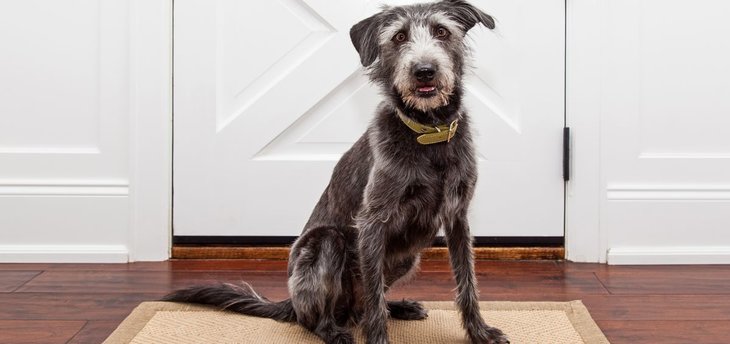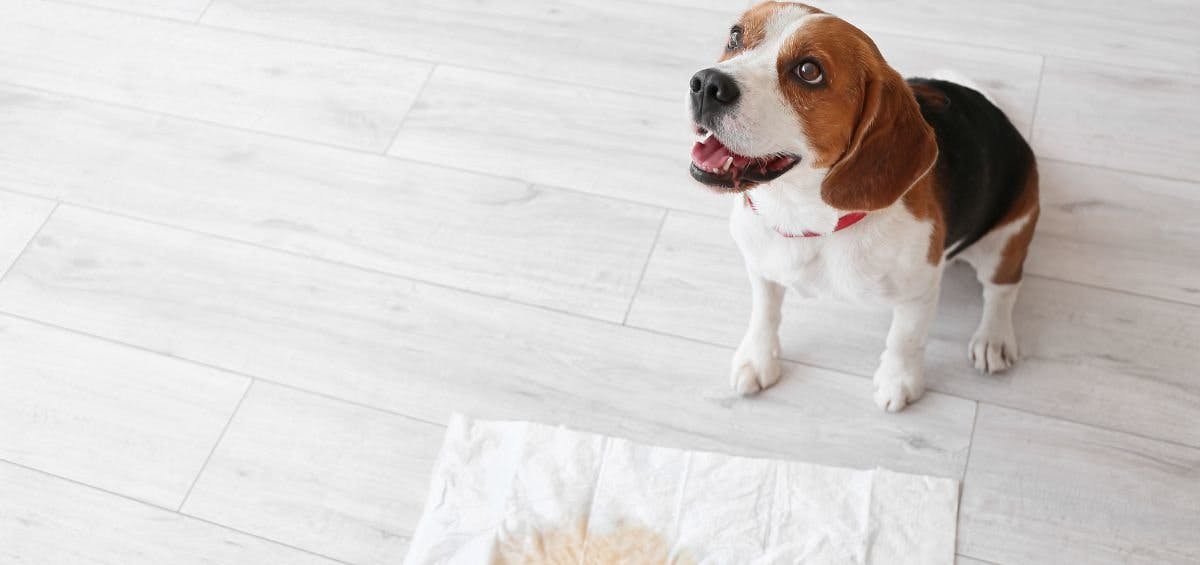How to Potty Train an Older Dog in 5 Steps
As your pooch enters their golden years, you may find that they are starting to display new behaviors, such as going to the bathroom indoors. If your older dog is peeing or pooping in the house or peeing in the house, they may be showing the first signs of incontinence.
Incontinence, or the lack of voluntary control over urination or defecation, might make you wonder how to potty train an older dog and what tools there are to assist your aging friend. Doggie pee pads are one great example that can help older pets maintain their independence while keeping your home clean.
If you’re wondering how to potty train an older dog, this article will teach you the step-by-step technique to train a dog to use a pee pad indoors to help them maintain a good quality of life in their senior years with fewer accidents around the house.
Table of Contents:
Why is my older dog peeing in the house?
As pets age, their abilities may start to decline, which can make using a pee pad beneficial. Here are a few examples of health conditions in older dogs that may be causing your senior to suddenly go to the bathroom indoors:
Incontinence
Many senior dogs are affected by urinary incontinence but it’s most prevalent in spayed female, large breed dogs (11%-20%). It occurs when the muscles around a dog’s bladder start to weaken, leading to the involuntary release of urine, often when the dog is sleeping or lying down.
11-20% of spayed females
experience incontinence in large dog breeds
Joint aches and pains
Stiffness and pain in dog joints can make going on walks outside more challenging. If your dog's mobility is reduced by arthritis or injury, then always going to the bathroom outside may not be feasible anymore. An indoor potty pad for dogs gives your pet the option to go inside or outside depending on how they feel.
Dementia
If a dog's cognitive abilities start to decline, they may forget their housetraining and begin to soil different areas of the house. They may no longer signal to you that they need to go outside and use the bathroom and could be forced to go inside when they can no longer hold it.
Note: It’s important to take your pet to a veterinarian whenever you observe any changes to their physical or mental behavior to ensure they are getting the right care. Pet insurance for older dogs helps families save money at the vet by offsetting the cost of treating health conditions that commonly arise as dogs get older.
How to potty train an older dog
1. Set up for success
There are many different options on the market that you can choose from when potty training older dogs. Choosing the one best suited to your pet’s specific needs can help set you up for success, so be sure to take their size, level of mobility, and unique health concerns into consideration.
For instance, pee pads for adult dogs are made with a special backing that is more absorbent than the standard plastic found in most puppy pads. Some may have adhesive strips that allow you to secure them to the floor to prevent your dog from slipping when using them. Disposable pee pads are great for ease of use, while washable and reusable options can be more cost-effective and environmentally friendly.
Dog potties are another eco-friendly alternative. They often have pheromones that mimic the scent of bark or real grass, which act as an attractant to provide additional encouragement. This can be very useful for senior pets with dementia because it helps your dog associate the smell with the location of their bathroom.
2. Choose the right location
In terms of location, note that canines have a natural instinct to avoid defecating where they eat or sleep. It's best to place the pee pad away from those areas in a quiet place in the house. It should be easily accessible and always in the same spot so they can find it quickly. Avoid placing it somewhere that would require your dog to climb stairs or walk a long distance.
3. Learn the cues
Now that you have the pee pad chosen and in place, you can start to learn the cues your dog gives when they need the bathroom. These can include:
- Walking to and staying around the door to show they need to go outside
- Excessively sniffing the floor in search of a place to go to the toilet
- Pacing back and forth
- Circling
- Whining

When you spot this body language, you can lead your dog to the pee pad and encourage them to get on it. If you have used commands such as "go potty" before, you can use those for encouragement.
4. Be positive and encouraging
The training process will take lots of patience so remaining positive is key. It's important to remember that a dog who has spent most of their lives going to the bathroom outside will take time to adjust to going inside. Offer treats and pets when they do use the pee pad to encourage them to keep repeating the action.
5. Repeat the process
Continue to place your senior dog onto the pee pad when you spot the cues that they need the bathroom. In time they will learn that it is acceptable for them to relieve themselves while inside, without experiencing the shame or guilt that dogs typically feel when having an accident in the house.
The purpose of potty training an older dog with pee pads is not to remove outside bathroom breaks entirely but to give your dog the option to go inside if they need to. As pets get older, their ability to hold their waste can become impaired. They may need to be taken outside more frequently, which can be challenging to accommodate.
Getting your dog to use a pee pad can be a great tool when you can’t reduce the time between bathroom breaks because you’re away at work or sleeping through the night, to name a couple of examples.
Key Takeaways
Potty training older dogs can be a difficult task, but it is possible to teach old dogs new tricks — and doing so can help reduce the number of indoor accidents that commonly occur in senior pets as their health begins to deteriorate. Just like training a puppy, consistency and encouragement are essential. Use pee pads or dog potties to
Pro Tip: Did you know that pet insurance can help pay for training if your dog develops a new behavioral disorder at a late age? Learn more about pet insurance and how it works to protect you and your canine companion at Pawlicy Advisor.
Do you want to find the best pet insurance?
Let's analyze your pet's breed, age, and location to find the right coverage and the best savings. Ready?
Analyze My PetAbout Pawlicy Advisor
The pet insurance marketplace endorsed by veterinarians, at Pawlicy Advisor we make buying the best pet insurance easier. By comparing personalized coverage and pricing differences we can save you a ton of money, up to 83% in some instances!
Instantly Compare Pet Insurance Plans
Guides
Determine If Pet Insurance Is Worth It
Comparison Charts
Find Your State
Dog Insurance
DVM
Ricky Walther, DVM, is a small animal general practitioner in the greater Sacramento, California area. Realizing the positive financial and medical impact that pet insurance can provide for pet parents and the profession, he lends support and advice to companies like Pawlicy Advisor "The Pet Insurance Marketplace") that simplify the process of connecting with veterinary financing resources.
